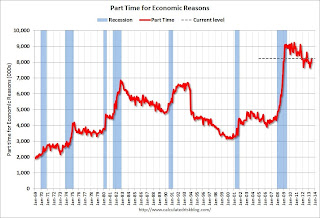by Calculated Risk on 7/05/2013 11:04:00 AM
Friday, July 05, 2013
Employment Report: More Hiring, Wages Up, Still Weak Labor Market
The good news: This was the best first half for private employment gains since 1999. Also hourly and weekly wages increased 0.4% in June, and hourly wages are now up 2.2% over the last year (weekly wages are up 2.5% year-over-year).
Some bad news: the employment-population ratio for the 25 to 54 year old group (prime working age) declined, the number of part time workers (for economic reasons) increased and U-6 (an alternative measure of labor underutilization) increased to 14.3%.
Some numbers: Total nonfarm employment is up 2.293 million over the last 12 months, and up 1.211 million so far in 2013 (a 2.42 million annual pace).
Private employment is up 2.357 million over the last year, and up 1.234 million so far in 2013 (a 2.47 million annual pace). The following table shows the first and second half and full year changes in private employment since 1998.
| Change in Private Payrolls (000s) | |||
|---|---|---|---|
| Year | First Half | Second Half | Full Year |
| 1998 | 1,389 | 1,312 | 2,701 |
| 1999 | 1,296 | 1,413 | 2,709 |
| 2000 | 953 | 727 | 1,680 |
| 2001 | -773 | -1,535 | -2,308 |
| 2002 | -531 | -234 | -765 |
| 2003 | -366 | 470 | 104 |
| 2004 | 1,111 | 761 | 1,872 |
| 2005 | 1,211 | 1,087 | 2,298 |
| 2006 | 1,109 | 753 | 1,862 |
| 2007 | 688 | 139 | 827 |
| 2008 | -861 | -2,936 | -3,797 |
| 2009 | -3,876 | -1,100 | -4,976 |
| 2010 | 434 | 801 | 1,235 |
| 2011 | 1,209 | 1,211 | 2,420 |
| 2012 | 1,146 | 1,123 | 2,269 |
| 2013 | 1,234 | ||
Of course public payrolls are continuing to shrink (four plus years of declining public payrolls now). Public employment was down 7 thousand in June (mostly at the Federal level), and public employment is down 64 thousand over the last year, and down 23 thousand so far in 2013 (a 46 thousand annual pace).
A few more graphs ...
Employment-Population Ratio, 25 to 54 years old
 Click on graph for larger image.
Click on graph for larger image.Since the participation rate declined recently due to cyclical (recession) and demographic (aging population) reasons, an important graph is the employment-population ratio for the key working age group: 25 to 54 years old.
In the earlier period the employment-population ratio for this group was trending up as women joined the labor force. The ratio has been mostly moving sideways since the early '90s, with ups and downs related to the business cycle.
The ratio decreased to 75.9% in June from 76.0% in May. This ratio should probably move close to 80% as the economy recovers.
The participation rate for this group also decreased in June to 81.1%. The decline in the participation rate for this age group is probably mostly due to economic weakness (as opposed to demographics) and this suggests the labor market is still very weak.
Percent Job Losses During Recessions

This graph shows the job losses from the start of the employment recession, in percentage terms - this time aligned at maximum job losses.
In the earlier post, the graph showed the job losses aligned at the start of the employment recession.
This financial crisis recession was much deeper than other post WWII recessions, and the recovery has been slower (the recovery from the 2001 recession was slow too). However, if we compare to other financial crisis recoveries, this recovery has actually been better than most.
Part Time for Economic Reasons
 From the BLS report:
From the BLS report:The number of persons employed part time for economic reasons (sometimes referred to as involuntary part-time workers) increased by 322,000 to 8.2 million in June. These individuals were working part time because their hours had been cut back or because they were unable to find a full-time job.The number of part time workers increased in June to 8.226 million.
These workers are included in the alternate measure of labor underutilization (U-6) that increased to 14.3% in June from 13.8% in May.
Unemployed over 26 Weeks
 This graph shows the number of workers unemployed for 27 weeks or more.
This graph shows the number of workers unemployed for 27 weeks or more. According to the BLS, there are 4.328 million workers who have been unemployed for more than 26 weeks and still want a job. This was down slightly from 4.357 million in May. This is trending down, but is still very high. Long term unemployment remains one of the key labor problems in the US.
State and Local Government
 This graph shows total state and government payroll employment since January 2007. State and local governments lost jobs for four straight years. (Note: Scale doesn't start at zero to better show the change.)
This graph shows total state and government payroll employment since January 2007. State and local governments lost jobs for four straight years. (Note: Scale doesn't start at zero to better show the change.) In June 2013, state and local governments lost 2,000 jobs, and state and local employment is up 23 thousand so far in 2013.
I think most of the state and local government layoffs are over. Of course total public employment declined again as the Federal government layoffs are ongoing - and with many more layoffs expected.
Overall this was a solid report - especially with the upward revisions to April and May employment and the pickup in wage gains. But the labor market is still weak and millions of people are unemployed or underemployed.


